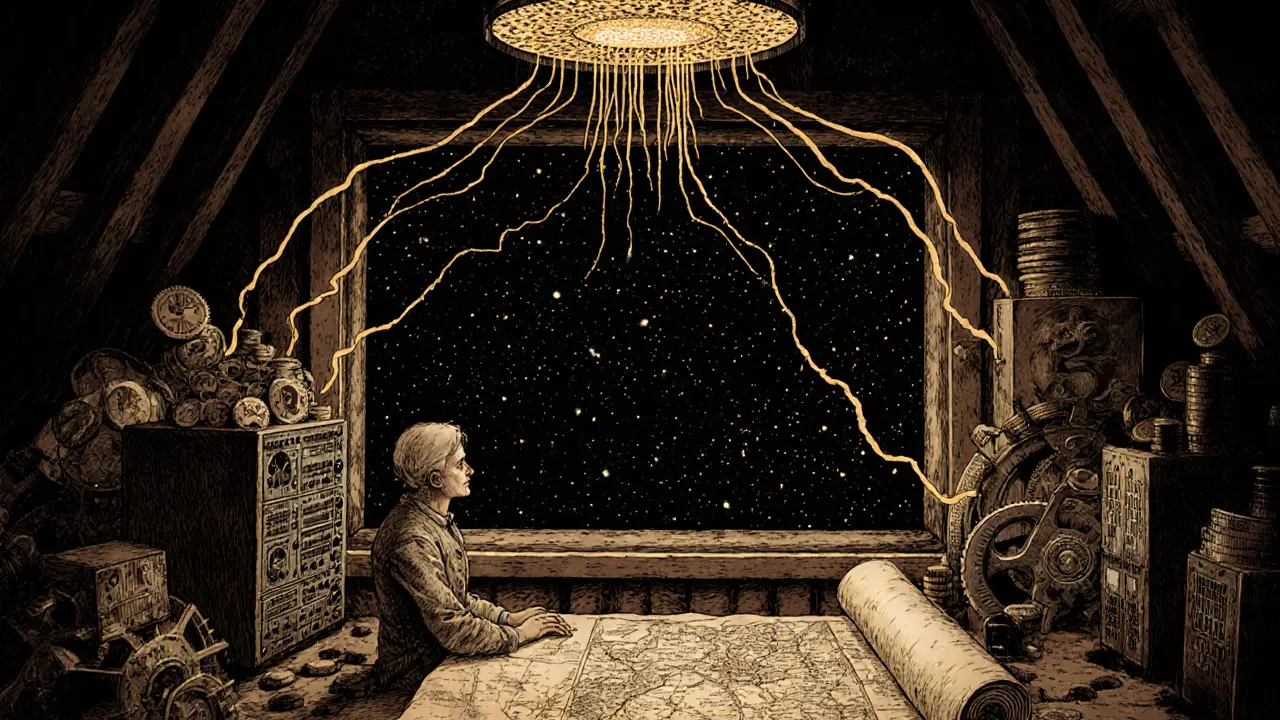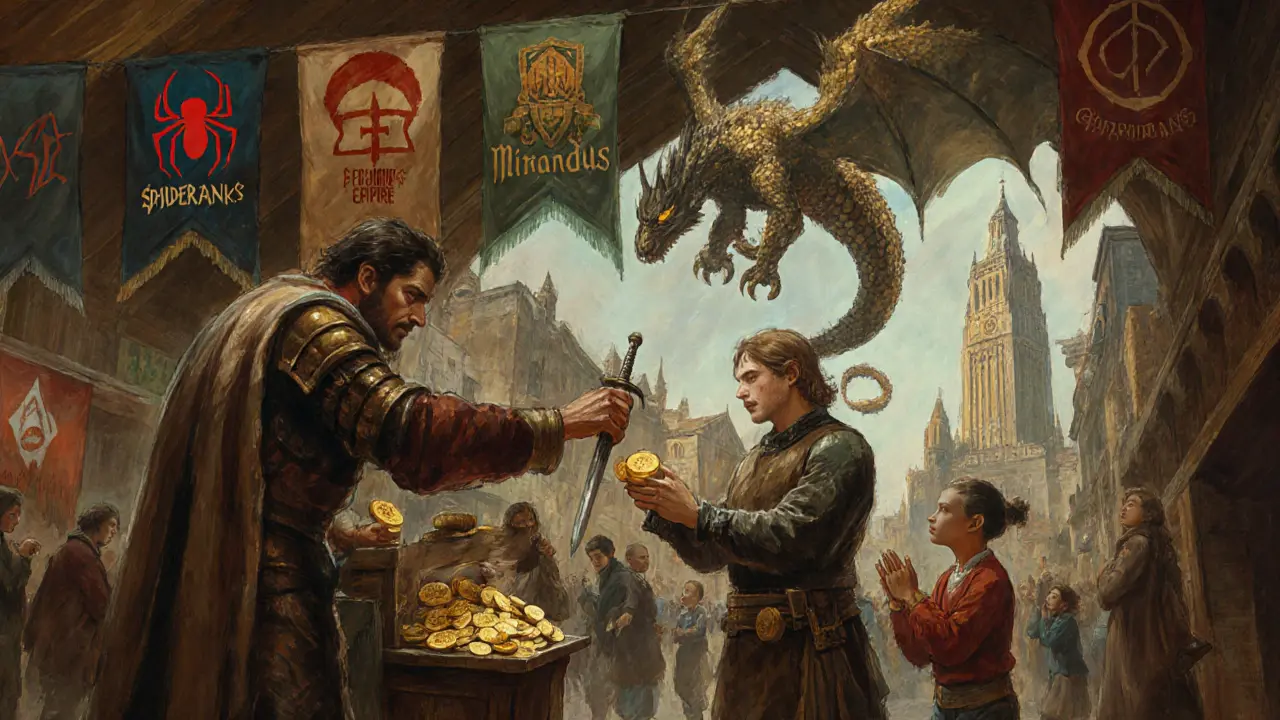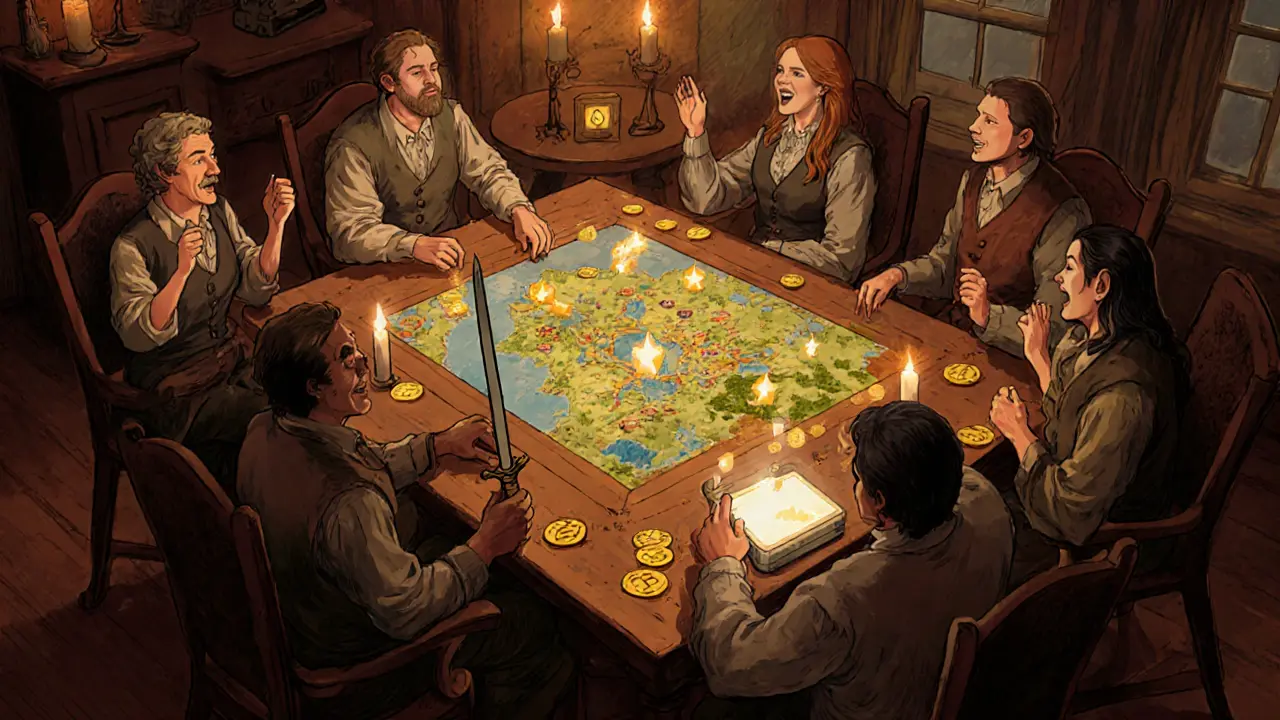GALA Node Profit Calculator
How to Calculate Your Node Earnings
The Gala Games network rewards node operators with GALA tokens for maintaining network stability. Your earnings depend on uptime, GALA price, and node cost.
Your Potential Earnings
Note: Actual rewards may vary based on network conditions and node performance. Minimum uptime is 6 hours per day to qualify for daily rewards.
GALA is the native cryptocurrency of Gala Games, a blockchain-based gaming platform that lets players own, trade, and earn digital items in games. Unlike traditional games where in-game items are locked inside the game, Gala Games uses blockchain to give players real ownership. This means if you buy a sword, a piece of land, or a rare character in a Gala game, it’s yours - not the company’s. You can sell it, trade it, or use it across different games in the ecosystem. The GALA token is what makes all of this possible.
How Gala Games works
Gala Games isn’t just one game. It’s a whole network of games built on blockchain. Titles like Town Star, Mirandus, Echoes of Empire, and Spider Tanks all run on the same system. In each game, you can earn GALA tokens by playing, completing tasks, or helping run the network. You can also buy in-game items as NFTs - unique digital assets stored on the blockchain. These aren’t just cosmetic skins. They’re actual collectibles with real value that can be traded on marketplaces.
The platform was launched in 2019 by three gaming industry veterans: Eric Schiermeyer (co-founder of Zynga, maker of FarmVille), Michael McCarthy (ex-CTO of MySpace), and Wright Myers (ex-Facebook). Their goal? To fix the broken model of online gaming, where companies profit from players while players get nothing in return. Gala Games flips that script. Players help run the network, and they get rewarded for it.
What is the GALA token used for?
The GALA token isn’t just a currency. It has three main roles:
- Utility currency: You use GALA to buy Founder’s Nodes, in-game items, and other assets in the Gala ecosystem.
- Governance: If you own a Founder’s Node, you get voting rights on which games get developed next, how updates are made, and even how the network is upgraded.
- Network rewards: Running a node (a piece of software on your computer) helps keep the network running. In return, you get daily GALA rewards - but only if you keep the node active for at least six hours a day.
Nodes are the backbone of Gala’s system. Instead of relying on big data centers, Gala uses thousands of regular people’s computers to host its blockchain. As of 2025, over 16,000 nodes are running worldwide. Each node owner gets a share of new GALA tokens every day. It’s like mining Bitcoin, but you’re not using huge power-hungry machines - just your home PC.
How to get GALA
You can buy GALA on major crypto exchanges like Binance, KuCoin, and Gate.io. As of October 31, 2025, the price is around $0.01005. With a circulating supply of 46 billion tokens, the total market cap sits at roughly $465 million.
But buying GALA isn’t the only way to get it. You can earn it by:
- Playing Gala Games and completing daily quests
- Running a Founder’s Node (requires technical setup)
- Participating in community events or tournaments
Founder’s Nodes cost between 5,000 and 50,000 GALA tokens, depending on the tier. You can also pay with ETH or BAT. Once you own one, you start earning rewards immediately. But there’s a catch: setting up a node isn’t easy. You need a decent computer (4GB RAM, 2 CPU cores, 50GB storage), and you have to install software on Windows, macOS, or Linux. Many users report a steep learning curve, with some taking weeks to get it working smoothly.

Price predictions and market reality
The price of GALA has been all over the place. In early 2024, some analysts predicted it could hit $0.50 by the end of 2025. Others said it might drop below $0.01. As of late 2025, the market is leaning toward the bearish side.
Here’s what the data shows:
- CoinMarketCap (October 31, 2025): $0.01005
- CoinCodex: Predicts $0.01003 by end of 2025
- TradingBeast: Projects $0.053 by 2030
- CoinLore: Forecasts $0.5488 in 2025 (highly optimistic)
- WalletInvestor: Predicts $0.001954 by 2030
The wide gap between predictions shows how uncertain the market is. Some see potential in Gala’s growing game library and node network. Others point to declining GameFi adoption - daily active wallets in the sector dropped 32% in 2023, and GameFi overall lost 17% in Q2 2025. Binance’s recent decision to reduce GALA’s collateral ratio to 40% also spooked investors, causing a short-term dip.
Who’s using Gala Games?
Gala Games claims 1.3 million monthly active users. That’s a lot - but it’s unclear how many of them are actually earning or spending GALA. Many users play for fun, not for profit. Trustpilot reviews give the platform a 3.2/5 rating. People love the games - especially Town Star and Spider Tanks - but they’re frustrated by the token’s price swings and the complexity of running nodes.
One Reddit user put it well: “The games are fun, but GALA’s price doesn’t reflect the user growth I see.” Another said: “I spent weeks setting up my node, and my daily rewards barely cover my electricity bill.”
There’s a real disconnect between the ecosystem’s activity and the token’s value. The platform has sold over 26,000 NFTs, and it’s expanding into music and film with Gala Music and Gala Film. But unless more users start buying and holding GALA - not just playing games - the token’s value won’t grow sustainably.

Is GALA a good investment?
It depends on what you’re looking for.
If you’re a gamer who wants to own your items and earn while playing, then yes - Gala Games offers something unique. You’re not just spending money on a game. You’re investing in a system that gives you back control.
If you’re looking for quick crypto gains, be careful. GALA has been stuck in a narrow range for months. The technical setup for nodes is a barrier for most people. And with regulatory pressure growing - the SEC has started looking at gaming tokens as potential securities - the future isn’t guaranteed.
What’s working? The team has real gaming experience. They’ve hired ex-EA executives. They’re building multiple games, not just one. And they’ve moved from Ethereum to their own blockchain (GalaChain) to make transactions faster and cheaper. That’s a smart move.
What’s not working? The token’s value isn’t tied to real demand. Most people aren’t buying GALA to use it - they’re buying it hoping it’ll go up. That’s a risky foundation.
What’s next for Gala and GALA?
In 2024, Gala Games launched GalaChain, its own blockchain, to handle gaming traffic better. In 2025, they announced plans to release GalaChain as an enterprise solution for non-gaming apps - like digital tickets, loyalty programs, or even art collections. That’s a big shift. They’re no longer just a gaming company. They’re trying to become a blockchain infrastructure provider.
They’re also talking about integrating with gaming consoles, though no deals have been confirmed. If they can get Gala Games on PlayStation or Xbox, it could bring in millions of new players overnight.
For now, GALA is a token with potential but no clear path to mass adoption. It’s a bet on the idea that players will eventually care more about owning their digital stuff than they care about flashy graphics or loot boxes. Whether that bet pays off depends on whether the ecosystem can turn casual players into active token users.
Final thoughts
GALA isn’t another meme coin. It’s tied to a working product - a network of games with real players. But it’s also not a sure winner. The token’s value is still disconnected from the platform’s usage. If you’re curious, try playing one of their free games. See if you like it. If you do, and you’re comfortable with a bit of tech, try running a node. Don’t buy GALA hoping for a quick profit. Buy it because you believe in the idea that players should own what they earn.
The real question isn’t whether GALA will go up in price. It’s whether the people playing these games will ever start using the token the way it was meant to be used - not as a speculation tool, but as the engine that powers their gaming experience.

Eric Redman
November 1, 2025 AT 14:46This whole thing is a scam. Players don't own anything - the company just rebrands loot boxes with blockchain buzzwords. I've seen this movie before, and it ends with everyone losing money.
Brett Benton
November 2, 2025 AT 03:34Man, I tried Town Star last year just to see what all the hype was about. The gameplay is actually solid - way better than most mobile free-to-plays. But yeah, the token? Worthless. I earned like 20 GALA in a week and couldn't even buy a single skin. Feels like they're just pumping the token while the games stay fun. I still play, but I don't touch the coin anymore.
Jason Coe
November 2, 2025 AT 15:15Look, I get the frustration with GALA's price, but you're missing the bigger picture. The real innovation here isn't the token - it's the node network. Thousands of regular people running full nodes on their home PCs? That's decentralized infrastructure built by gamers, not venture capitalists. Most crypto projects rely on centralized servers or big mining farms. Gala flips that. Yeah, setting up a node is a pain - I spent three weeks troubleshooting it myself - but once it's running, you're not just a player, you're part of the backbone. And the fact that they're now licensing GalaChain for non-gaming apps? That's the real play. They're not just betting on gamers. They're betting on blockchain as a utility layer. If they pull this off, GALA could be the Ethereum of gaming infrastructure, not just a gambling token.
Helen Hardman
November 4, 2025 AT 07:26I love how people act like owning NFTs in games is some revolutionary concept, but honestly? If I can't trade my sword on Steam or eBay, what's the point? I play games to escape, not to manage crypto portfolios. And don't get me started on nodes - I'm not running a server just to earn 0.003 GALA a day. That's less than a penny. I'd rather just buy a coffee. The games are fun, sure, but the token is a distraction. Why can't they just make good games without the blockchain theater?
Genevieve Rachal
November 5, 2025 AT 17:13Let's be real: 46 billion tokens in circulation at $0.01? That's a death trap. No fundamental value. No real demand. Just hype from people who think 'play-to-earn' means 'get rich quick.' And now they're trying to pivot to enterprise? Please. If they can't get their core user base to actually use the token, why would anyone trust them to build infrastructure? This isn't Web3. It's Web3.0 - the version where the tech is ahead of the use case. And it's going to crash hard.
Vicki Fletcher
November 7, 2025 AT 05:53i just tried to set up a node... after 2 weeks of reading forums, watching videos, and reinstalling everything... i finally got it running... and then my rewards dropped because i forgot to update the firewall settings... i think i spent more time fixing this than i did playing the game... and i still only got like 0.008 galas a day... i just wanna play spider tanks without being a sysadmin
Phil Higgins
November 8, 2025 AT 11:49The deeper question here isn't whether GALA will rise or fall - it's whether we, as a culture, are ready to accept that digital ownership matters. We accept that we own our cars, our homes, our books - but when it comes to digital artifacts, we're conditioned to believe they're rented. Gala challenges that. Even if the token fails, the idea - that your in-game effort should yield tangible, portable value - is revolutionary. The problem isn't the tech. It's the mindset. Most people still think of games as disposable entertainment. Gala says: no, this is your labor. And that terrifies the old guard.
Mehak Sharma
November 9, 2025 AT 11:51As someone from India who plays Town Star daily, I can say this: the games are genuinely well-made, and the community is surprisingly warm. But the token? It's a ghost. I've seen friends earn hundreds of GALA and then sell it for pennies because they need rent money. The system rewards patience, but most people don't have it. Still, I keep playing - not for the coin, but because I like building my town, trading with others, and seeing my progress. Maybe the token will catch up. Maybe not. But the games? They're real. And that's worth something.
Debby Ananda
November 9, 2025 AT 21:18OMG I'm so done with this. Like, I get it, you're trying to be 'decentralized' but you're just giving people a new way to lose money 😭 I bought GALA at $0.05 and now I'm down 80%. I feel like I'm living in a dystopian cartoon where the only thing more toxic than the market is the community. I just want to play games without feeling like I'm in a crypto cult 🙄
Malinda Black
November 10, 2025 AT 22:05Hey, if you're new to this - don't panic. The market is noisy, but the platform is growing. Try playing one game for free. See if you enjoy it. If you do, maybe consider running a node - even a basic one. You don't need a supercomputer. Just a quiet PC and some patience. The rewards are small now, but the network is expanding. And if you believe in player ownership, you're not just investing in a coin - you're investing in a better way to game. Take it slow. Don't chase pumps. Be part of the change.
Chris Strife
November 12, 2025 AT 00:39US government is watching this. SEC is already labeling gaming tokens as securities. Gala is a walking lawsuit waiting to happen. They're pretending this is innovation when it's just a shell game. Don't be fooled. The only thing being decentralized is the loss.
Phyllis Nordquist
November 12, 2025 AT 23:41While the speculative nature of GALA is concerning, the underlying architecture of Gala Games represents a meaningful attempt to realign incentives between developers and players. The transition from Ethereum to GalaChain demonstrates technical foresight, and the integration of node-based consensus - rather than centralized validation - is a pragmatic model for scalable blockchain gaming. The challenge lies not in the technology, but in user education and sustainable tokenomics. Without a clear, frictionless pathway for non-technical players to engage with the ecosystem, adoption will remain niche. The vision is sound, but execution requires more than optimism - it requires deliberate, user-centered design.
Nadiya Edwards
November 13, 2025 AT 05:04Let’s not pretend this isn’t just another Wall Street scam dressed up as a game. They’re using ‘player ownership’ as a marketing hook to lure in suckers while insiders dump their tokens. The fact that Binance lowered the collateral ratio says it all. This isn’t a revolution - it’s a pump-and-dump with a better UI. If you’re not a whale, you’re just feeding the machine.
ISAH Isah
November 15, 2025 AT 02:43Bhavna Suri
November 17, 2025 AT 00:57This is too complicated. I just want to play games. Why do I need to run a node? Why do I need to understand blockchain? Why is the price so low? I don't get it. I think it is a waste of time.
Ron Cassel
November 18, 2025 AT 06:30Did you know Gala is secretly funded by the same people who ran MySpace? They’re not building a game platform - they’re building a data harvesting engine disguised as blockchain. Every time you play, they’re tracking your habits, your play patterns, your spending - and selling it. The ‘node’ is just a Trojan horse. Your PC isn’t helping the network - it’s being used to mine your behavioral data. Wake up. This isn’t Web3. It’s Web3.0 - the surveillance version.
Eli PINEDA
November 18, 2025 AT 22:16so i just tried playing mirandus and it was kinda cool but then i tried to buy a sword and it asked me to connect my wallet and i had no idea what i was doing and then my browser crashed and now i think i might have a virus?? help??